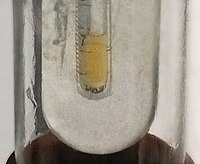
Photo from wikipedia
Byproduct formation (chlorate, bromate, organic halogen, etc.) during sulfate radical (SO4•-)-based processes like ultraviolet/peroxymonosulfate (UV/PMS) has aroused widespread concern. However, hypohalous acid (HOCl and HOBr) can form via two-electron transfer… Click to show full abstract
Byproduct formation (chlorate, bromate, organic halogen, etc.) during sulfate radical (SO4•-)-based processes like ultraviolet/peroxymonosulfate (UV/PMS) has aroused widespread concern. However, hypohalous acid (HOCl and HOBr) can form via two-electron transfer directly from PMS, thus leading to the formation of organic halogenated byproducts as well. This study found both PMS alone and UV/PMS can increase the toxicity to mammalian cells of wastewater, while the UV/H2O2 decreased the toxicity. Cytotoxicity of two wastewater samples increased from 5.6-8.3 to 15.7-29.9 mg-phenol/L, and genotoxicity increased from 2.8-3.1 to 5.8-12.8 μg 4-NQO/L after PMS treatment because of organic halogen formation. Organic halogen formation from bromide rather than chloride was found to dominate the toxicity increase. The SO4•--based process UV/PMS led to the formation of both organic halogen and inorganic bromate and chlorate. However, because of the very low concentration (<20 μg/L) and relatively low toxicity of bromate and chlorate, contributions of inorganic byproducts to toxicity increase were negligible. PMS would not form chlorate and bromate, but it generated a higher concentration of total organic halogen, thus leading to a more toxic treated wastewater than UV/PMS. UV/PMS formed less organic halogen and toxicity because of the destruction of byproducts by UV irradiation and the removal of byproduct precursors. Currently, many studies focused on the byproducts bromate and chlorate during SO4•--based oxidation processes. This work revealed that the oxidant PMS even needs more attention because it caused higher toxicity due to more organic halogen formation.
Journal Title: Environmental science & technology
Year Published: 2023
Link to full text (if available)
Share on Social Media: Sign Up to like & get
recommendations!